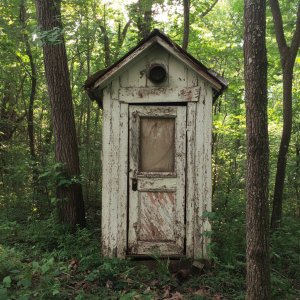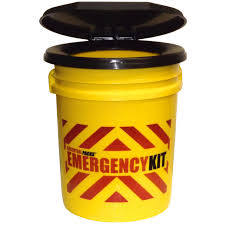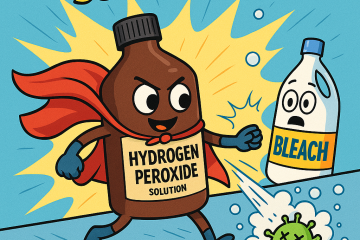
Will outhouses make a comeback in a society down scenario?
Let’s face it: when society breaks down, we’re all in deep… well, you know. I know it can seem daunting. But don’t worry. This article will help you handle your business when traditional plumbing decides to clock out. Because in a world gone mad, the last thing you want is to turn your living area into a biohazard zone. So, hold your nose, we’re going in!
Understanding the Risks (It’s a Crappy Situation)
Untreated human waste can spread diseases faster than rumors in a high school. We’re talking about:
- Cholera (the OG of waterborne diseases)
- Typhoid (not the fun kind of fever)
- Hepatitis A (your liver’s worst enemy)
- Dysentery (Oregon Trail players know this one all too well)
Proper management isn’t just crucial; it’s the difference between surviving the apocalypse and starring in your own personal horror movie.
Emergency Toilet Options (Throne Away From Home)
- The Bucket Brigade
- Use a 5-gallon bucket with a toilet seat lid (fancy!)
- Line with heavy-duty garbage bags (double-bag for the paranoid)
- Add a layer of sawdust, peat moss, or fine wood shavings after each use (we’re composting, not marinating)
- The Pit Stop
- Dig a pit at least 4 feet deep, 100 feet away from water sources
- Create a simple shelter for privacy (because we’re not animals, for Pete’s sake.)
- Cover waste with soil after each use (bury the evidence)
- The Composting Throne
- Separates liquid and solid waste (yellow and brown, if you will)
- Uses carbon-rich materials to aid decomposition
- It’s like a science project, but stinkier
Products That Help Break Down Waste (Chemical Cavalry to the Rescue)
Here’s a list of products that can help you tackle the stinky situation:
- Enzyme Treatments
- RID-X Septic Tank Treatment
- Cabin Obsession Septic Tank Treatment
- Roebic K-37 Liquid Bacteria Septic Tank Treatment
- How they work: These contain bacteria and enzymes that feast on waste like it’s an all-you-can-eat buffet (sorry, I couldn’t resist)
- Chemical Treatments
- Walex Porta-Pak Holding Tank Deodorizer

Luggable loo
- Thetford Aqua-Kem Holding Tank Treatment
- Camco TST Ultra-Concentrated Orange Citrus Scent RV Toilet Treatment
- How they work: These use chemicals to break down waste and control odors. Less eco-friendly, but desperate times call for desperate measures
- Walex Porta-Pak Holding Tank Deodorizer
- Natural Additives
- Gotta Go Coconut Coir Blocks
- Peat moss (any brand)
- Wood ash from your campfire
- How they work: These absorb liquids and help control odors naturally. Think of them as nature’s air fresheners
- EM (Effective Microorganisms)
- TeraGanix EM-1 Microbial Inoculant
- SCD Probiotics All Seasons Indoor Composter
- How they work: These beneficial microorganisms work like tiny janitors, cleaning up the mess
Safe Disposal Methods
- The Burial
- Dig a hole at least 12 inches deep, 100 feet from water sources
- Cover with 6 inches of soil (R.I.P. – Rest In Poo)
- Mark the area to prevent accidental digging (no one wants that surprise)
- Long-term Composting
- Requires a dedicated system separate from regular compost
- Must reach and maintain high temperatures (131°F/55°C) for extended periods
- Should be aged for 1-2 years before use (good things come to those who wait)
- Catholes (for wilderness situations)
- Dig a hole 6-8 inches deep, 4-6 inches in diameter
- Cover with soil and natural materials
- Located at least 200 feet from water sources (think of it as a really inconvenient bathroom)
Hygiene and Safety Precautions (Don’t Be a Doo-Doo Head)
- Always wash hands thoroughly after handling waste (sing “Happy Birthday” twice while washing)
- Use gloves when possible (fashion and function!)
- Keep waste management areas away from living and food preparation spaces (no one wants that kind of seasoning)
- Regularly clean and disinfect toilet areas (pretend you’re in a cleaning product commercial)
Long-term Considerations (Planning for a Crappy Future)
- Rotate waste disposal areas to prevent soil contamination (musical toilets, anyone?)
- Consider learning about humanure composting for sustainable long-term solutions (it’s not just a hobby, it’s a lifestyle)
- Educate all community members about safe waste management practices (become the poo guru your community needs)

Avoid the Black Death repeat. Learn safe waste management.
Historical Lessons: When Waste Management Goes Wrong
Lest you think we’re making a stink about nothing, here are some grim examples from history where poor waste management/sanitation systems led to disastrous consequences:
- The Great Stink of London (1858): While not directly causing deaths, this event highlighted the dangers of poor sanitation. The hot summer caused the sewage-filled River Thames to emit an unbearable stench, forcing Parliament to address the city’s sanitation issues. This led to the construction of London’s modern sewer system, dramatically reducing waterborne diseases.
- Cholera Outbreaks in 19th Century Europe: In 1854, Dr. John Snow traced a London cholera outbreak to a contaminated water pump, proving the link between poor sanitation and disease. This discovery led to major improvements in urban water and waste systems, saving countless lives.
- Haiti Cholera Outbreak (2010-2019): Following the 2010 earthquake, a cholera epidemic struck Haiti, likely introduced by UN peacekeepers and spread through poor sanitation. It resulted in over 9,000 deaths and nearly 800,000 infections.
- Plague of Athens (430-426 BC): While the exact disease is debated, poor sanitation during the Peloponnesian War led to an epidemic that killed an estimated 75,000 to 100,000 people, or 25% of the city’s population.
- The Black Death (1347-1351): While primarily spread by fleas on rats, poor sanitation in medieval cities contributed to the rapid spread of the plague, which killed an estimated 30-60% of Europe’s population.
These examples serve as stark reminders of the importance of proper waste management as it compromises sanitation. In a crisis scenario, your toilet habits might just be the difference between life and death. So remember, folks: handle your business properly, or history might remember you as part of the “Great Stink of 2025”!
Stay safe, stay clean, and may your aim always be true. Ha!


